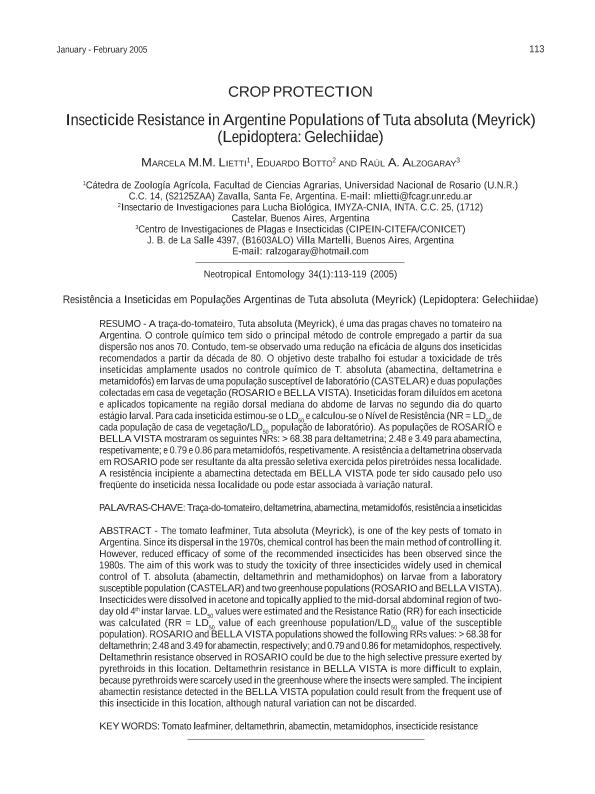Artículo
The tomato leafminer, Tuta absoluta (Meyrick), is one of the key pests of tomato in Argentina. Since its dispersal in the 1970s, chemical control has been the main method of controlling it. However, reduced efficacy of some of the recommended insecticides has been observed since the 1980s. The aim of this work was to study the toxicity of three insecticides widely used in chemical control of T. absoluta (abamectin, deltamethrin and methamidophos) on larvae from a laboratory susceptible population (CASTELAR) and two greenhouse populations (ROSARIO and BELLA VISTA). Insecticides were dissolved in acetone and topically applied to the mid-dorsal abdominal region of two-day old 4th instar larvae. LD50 values were estimated and the Resistance Ratio (RR) for each insecticide was calculated (RR = LD50 value of each greenhouse population/LD50 value of the susceptible population). ROSARIO and BELLA VISTA populations showed the following RRs values: > 68.38 for deltamethrin; 2.48 and 3.49 for abamectin, respectively; and 0.79 and 0.86 for metamidophos, respectively. Deltamethrin resistance observed in ROSARIO could be due to the high selective pressure exerted by pyrethroids in this location. Deltamethrin resistance in BELLA VISTA is more difficult to explain, because pyrethroids were scarcely used in the greenhouse where the insects were sampled. The incipient abamectin resistance detected in the BELLA VISTA population could result from the frequent use of this insecticide in this location, although natural variation can not be discarded. A traça-do-tomateiro, Tuta absoluta (Meyrick), é uma das pragas chaves no tomateiro na Argentina. O controle químico tem sido o principal método de controle empregado a partir da sua dispersão nos anos 70. Contudo, tem-se observado uma redução na eficácia de alguns dos inseticidas recomendados a partir da década de 80. O objetivo deste trabalho foi estudar a toxicidade de três inseticidas amplamente usados no controle químico de T. absoluta (abamectina, deltametrina e metamidofós) em larvas de uma população susceptível de laboratório (CASTELAR) e duas populações colectadas em casa de vegetação (ROSARIO e BELLA VISTA). Inseticidas foram diluídos em acetona e aplicados topicamente na região dorsal mediana do abdome de larvas no segundo dia do quarto estágio larval. Para cada inseticida estimou-se o LD50 e calculou-se o Nível de Resistência (NR = LD50 de cada população de casa de vegetação/LD50 população de laboratório). As populações de ROSARIO e BELLA VISTA mostraram os seguintes NRs: > 68.38 para deltametrina; 2.48 e 3.49 para abamectina, respetivamente; e 0.79 e 0.86 para metamidofós, respetivamente. A resistência a deltametrina observada em ROSARIO pode ser resultante da alta pressão seletiva exercida pelos piretróides nessa localidade. A resistência incipiente a abamectina detectada em BELLA VISTA pode ter sido causado pelo uso freqüente do inseticida nessa localidade ou pode estar associada à variação natural.
Insecticide resistance in Argentine populations of tuta absoluta (Meyrick) (Lepidoptera: Gelechiidae)
Título:
Resistência a Inseticidas em Populações Argentinas de Tuta absoluta (Meyrick) (Lepidoptera: Gelechiidae)
Fecha de publicación:
02/2005
Editorial:
Sociedade Entomológica do Brasil
Revista:
Neotropical Entomology
ISSN:
1519-566X
e-ISSN:
1678-8052
Idioma:
Inglés
Tipo de recurso:
Artículo publicado
Clasificación temática:
Resumen
Palabras clave:
Abamectin
,
Deltamethrin
,
Insecticide Resistance
,
Metamidophos
,
Tomato Leafminer
Archivos asociados
Licencia
Identificadores
Colecciones
Articulos(UNIDEF)
Articulos de UNIDAD DE INVESTIGACION Y DESARROLLO ESTRATEGICOS PARA LA DEFENSA
Articulos de UNIDAD DE INVESTIGACION Y DESARROLLO ESTRATEGICOS PARA LA DEFENSA
Citación
Lietti, Marcela; Botto, Eduardo Norberto; Alzogaray, Raúl Adolfo; Insecticide resistance in Argentine populations of tuta absoluta (Meyrick) (Lepidoptera: Gelechiidae); Sociedade Entomológica do Brasil; Neotropical Entomology; 34; 1; 2-2005; 113-119
Compartir
Altmétricas




